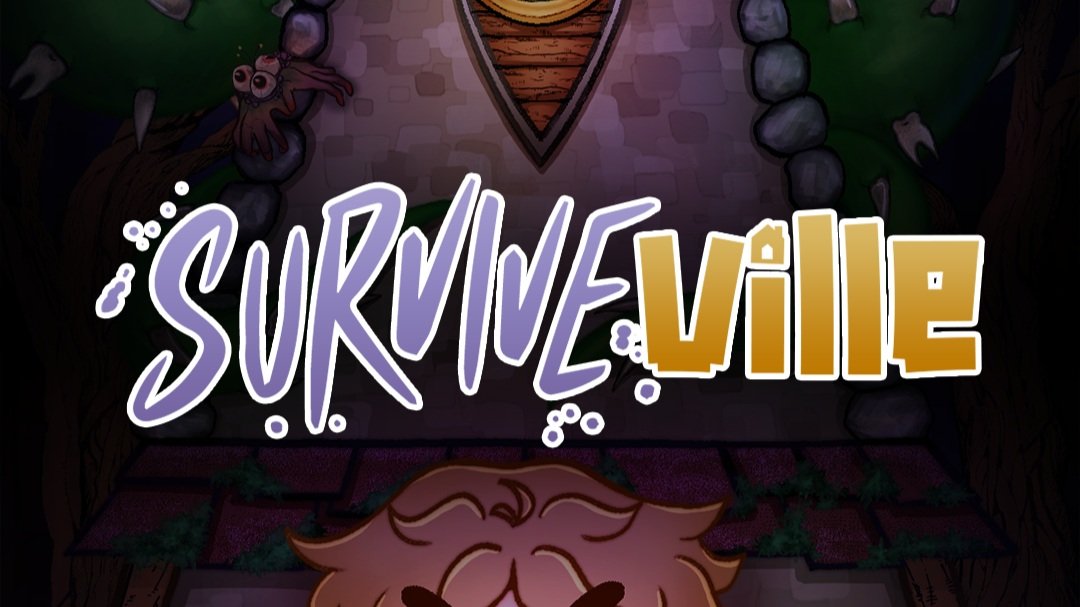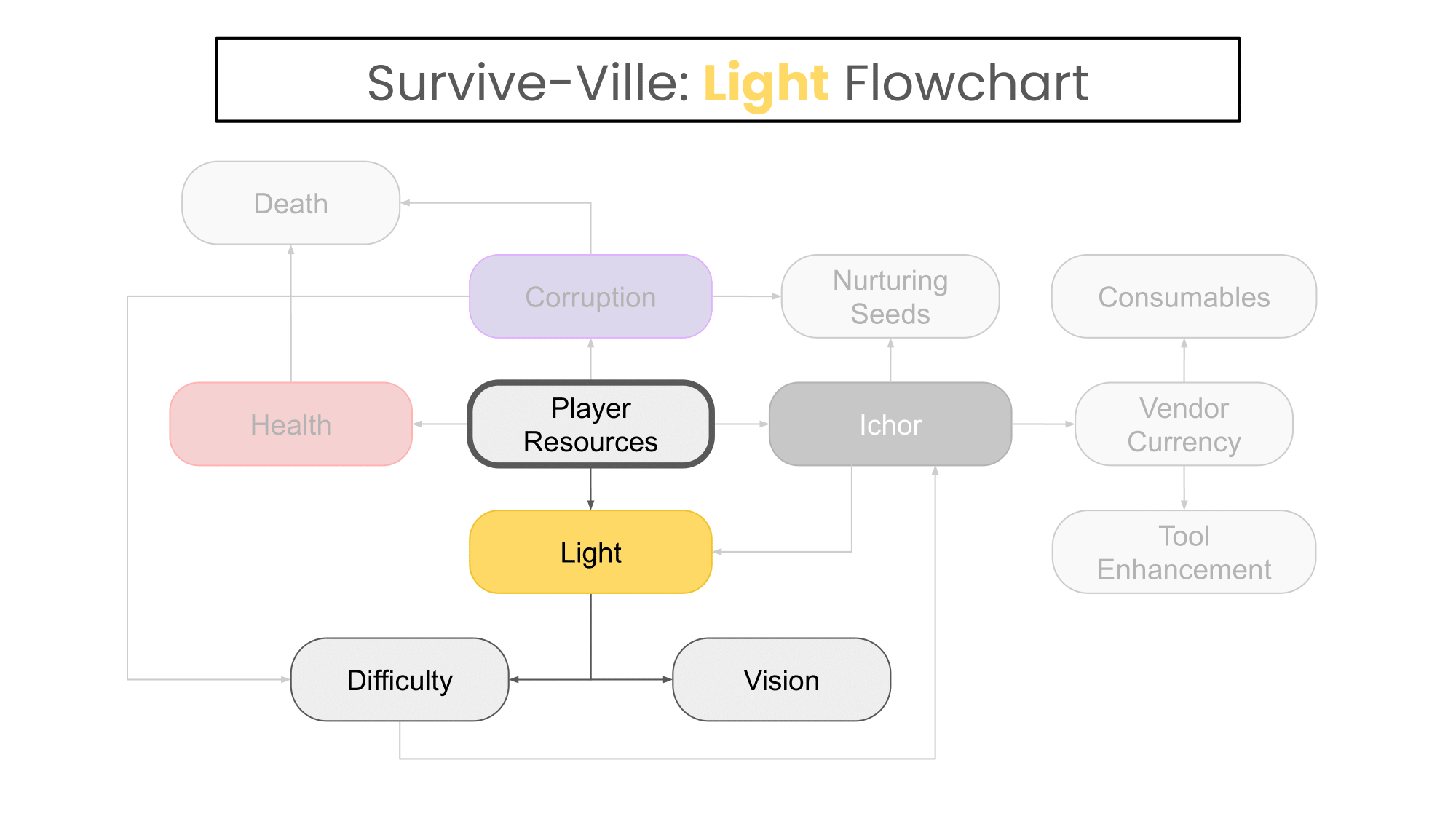
Survive-Ville
Player Resources and Management
Overview
The player resources are the core scaling attributes a player must manage during the Night Phase of the game. Each resource requires the attention of the player, and cumulatively, should function as means to control the progression and success of a player during a Night Phase.
Defining Resources
Resources are stock mechanics that a player must manage during their run.
Resources are allocated into their individual pools.
Each resource pool functions as a stock where “points” of that resource are saved by the game. This will also be conveyed to the player using UI elements.
Failure to manage these Resources efficiently should punish the player, if not outright lead to a fail state for the run.
There are 4 Resources:
Health
Corruption
Ichor
Light
Health: A player’s resistance to damage
The Role of Health
Limit the total number of mistakes a player can make during the run.
Present a punishment for poor engagement with enemies and respect for hazards.
Health is stored as Health Points (HP)
Health is stored within heart canisters, similar to Zelda
By default, the player has 3 Heart canisters
Each canister represents 2 Health Points (each hit takes half a heart)
Damage to Health
90% of all damage in the game will only remove 1 HP. This keeps expected damage from any source consistent and intuitive for the player.
In the 10% of cases otherwise, incoming damage will remove 2 HP. This increased damage should be reserved for special instances. Such things include:
Special boss attacks
Rare Mutated enemies (only prevalent with High Corruption)
Immunity
An internal cooldown for how often a player can receive damage prevents instances where the convergence of multiple enemies or hazards would instantly kill the player.
By extension, this should be accompanied by feedback that informs the player of their mistake (perhaps the player’s sprite briefly flashes with a “hit” sound)
This window of immunity should be brief, and merely give the player a moment to reposition.
Sources that Reduce Health
Level Hazards (lightning strikes, fissures, etc.)
Contact with enemies or enemy attacks (projectiles, AoEs, etc.)
Sources that Increase Health
Bought and/or crafted Consumables.
Rare consumable mushrooms that spawn scattered throughout a level.
Potential drops from the world environment (such as cutting tall grass).
Corruption: A player’s consequence of power
The Role of Corruption
Throttle the player’s scaling C-Pow (Cumulative Power) during a run.
Work with the current stage of the game to generate adaptive difficulty.
Create a persistent threat to the player's success, controlled by the risks they take.
Corruption is stored as Corruption Points (CorP)
When a source of Corruption is inflicted, it is added to the player equal to its CorP value.
Corruption is represented as a Gauge
This gauge has an attribute value between 0-100.
More likely than not, the player will not see the exact number. Instead being fed information about their current corruption by how full the gauge is.
The gauge is divided into 4 Tiers of Corruption.
Each Tier holds a total of 25 CorP.
How CorP fills the Gauge
If there is room in the gauge for the entire CorP value:
Add the value of CorP to the gauge.
If there is still room in the gauge, but not enough for the entire CorP value:
If the incoming CorP value is ≤ 25:
Fill the gauge to its maximum, ignoring the rest of the incoming CorP.
If the incoming CorP value is > 25:
The incoming CorP is treated as though there is no room.
If there is no room (the gauge is completely full):
The gauge overfills, and the player is punished accordingly.
If the gauge ever overfills, the player immediately dies.
This presents Corruption as a risky, persistent threat to a player’s safety in pursuit of power
Sources that increase Corruption
Nurturing Seeds
Improving one’s power is the most direct source of Corruption, and should serve as the primary interaction that increases CorP
Certain Vendor Interactions
Special Enemies
Boss attacks or special enemies could have attacks that apply minor amounts of Corruption
Sources that reduce Corruption
Rare environmental spawns
One time use mushroom rings could reduce a Tier of corruption, or destroying an optional objective could help cleanse the player
Expensive Consumables
Such consumables should be rare and/or exceedingly pricey to craft/obtain
Boss Encounters
Ichor: A player’s versatile currency
The Role of Ichor
A universal, per-run currency used for all methods of upgrades and management
Ichor is stored in the Bank
All Ichor is stored in a pool called The Bank. The Bank can store an infinite amount of Ichor.
This will likely be shown in the player’s UI as an “×” amount of Ichor and does not take up any physical space inside the player’s inventory.
Upon the conclusion of a run, all banked Ichor evaporates.
Sources of Ichor
Ichor is primarily meant to be dropped from the defeat of enemies. The more powerful an enemy is, the more total Ichor it has.
An enemy has a chance to drop some of its Ichor upon taking damage.
Up to half an enemy’s total Ichor can drop as a result of taking damage.
All an enemy’s remaining Ichor will drop upon defeat.
Dropped Ichor from enemies will always be scattered near its current position.
Ichor may also be a reward for completing Secondary Objectives within a level.
Ichor may rarely be a potential drop from the world environment (such as cutting tall grass).
Collecting Ichor
Ichor must be physically picked up by the player in order to add it to The Bank.
This is proximity based, and Ichor will have a slight “vacuum” effect when the player is near enough to it.
The collection of Ichor is automatic upon contact, requiring no action to initiate it.
If dropped Ichor is not collected within 5 seconds of spawning, then it evaporates.
Ichor about to vanish will have visual feedback to indicate its impending departure, such as an escalating (but not distracting) “smokey” VFX before it completely evaporates, or rapid blinking.
While the duration Ichor stays before vanishing can be adjusted, it should be quick. The player should feel pressured to collect it, and thus, rewarded when they do successfully.
Spending Ichor
Vendors
Interacting with vendors such a purchasing consumables, Tools, or other goods.
Nurturing Seeds
Upgrading a Seed costs an amount of Ichor to perform as part of its price.
Lantern Fuel
The player’s Vision depends on Ichor as a fuel source, and serves as a pressure on the player to constantly burn their currency to stay safe, or save up and risk the difficulty of darkness.
Light: A player’s Vision
The Role of Light
The player’s control of their Vision, affecting how much they can see in the darkness
Light uses The Lantern
A player’s Light is measured inside The Lantern.
The Lantern is a special piece of equipment always on the player. It does not take up a Weapon Slot or Inventory Space. It exists primarily as a UI element.
Lantern Fuel and Fuel Points (FP)
The Lantern uses a gauge. This gauge has an attribute value between 0-20.
This gauge can be filled with Ichor in order to generate Fuel.
1 Ichor contributes 1 Fuel Point (FP).
The gauge is divided into 4 Tiers of Light.
Each Tier holds a total of 5 FP.
Filling the Lantern
The Lantern will be accessible inside the player’s menu. Hovering over the UI element of The Lantern will prompt the player to feed it Ichor.
Pressing the requisite interaction button will feed 1 Ichor to The Lantern.
Holding the requisite interaction button will fill The Lantern completely, consuming the appropriate amount of Ichor needed to do so.
FP and Light
The player’s current Light is directly affected by The Lantern’s current Light Tier. The more FP the Lantern has, the brighter it burns.
16-20 FP = Full Light = 20ft of Vision
11-15 FP = High Light = 15ft of Vision
6-10 FP = Medium Light = 10ft of Vision
1-5 FP = Low Light = 5ft of Vision
0 FP = No Light = 0ft of Vision
Burn Time
Fuel burns at a rate of 1FP per 1 minute.
This can be adjusted, but the ideal sweet spot is the average player should have to spend ~30 total Ichor as FP per Level.
Not an annoyance to constantly manage, but nothing that can be ignored either.
Certain level effects and/or Seeds can influence Burn time.
Light and Difficulty
Because Light determines the player’s current Vision, Difficulty is directly affected.
The less a player can see, the more likely they will be surprised by enemies encroaching from the darkness, projectiles flying at them, terrain hazards, etc..
Because The Lantern uses Ichor to burn bright, the player is pressured to confront enemies.
Enemies drop Ichor which fuels their Vision.
Moving too slowly burns Ichor and can waste it over time.
Goals
Sense of mastery as the player engages with and becomes familiar with them.
Communicate predictable and intuitive game states such as success, danger, risk, and failure.
Resources should rely on each other to create a cohesive system where a player should care about each resource independently.




